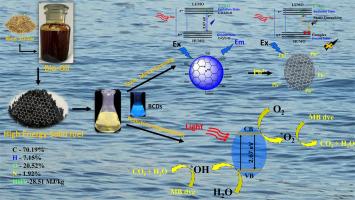Beyond traditional bio-oil potential: Converting to high-energy solid fuel, Pb²⁺ sensing carbon nanodots, and efficient photocatalysts for environmental applications
IF 6.3
3区 工程技术
Q1 ENGINEERING, CHEMICAL
Journal of the Taiwan Institute of Chemical Engineers
Pub Date : 2025-07-23
DOI:10.1016/j.jtice.2025.106306
引用次数: 0
Abstract
Background
Pyrolysis oil, typically derived from biomass, is primarily used as a liquid fuel or chemical feedstock. This study investigates an innovative method to expand the potential of rice straw-derived pyrolysis oil by converting it into high-energy bio-coal and bio-oil-derived carbon nanodots (BCDs).
Methods
Rice straw was subjected to slow pyrolysis to generate bio-oil, which was distilled to produce solid fuel, bio-coal. This bio-coal was then used as a precursor for the synthesis of fluorescence carbon nanodots through a hydrothermal process. The photocatalytic performance of BCDs was assessed by the degradation of methylene blue (MB) dye, and their capability to detect Pb²⁺ ions was examined through fluorescence quenching assays.
Significant Findings
The bio-coal exhibited remarkable fuel properties, including a high carbon content (70.19 %), low oxygen content (20.52 %), and high calorific value (28.51 MJ/kg), making it a promising alternative to fossil fuels. The BCDs, with an average size of 3.32 nm and a quantum yield of 17 %, demonstrated excellent sensitivity for Pb²⁺ detection (detection limit 5.6 μM) and photocatalytic degradation of MB dye (93.76 % in 180 min). The work aims to address both energy production challenges and environmental pollution, particularly focusing on the detection of Pb²⁺ ions and dye degradation in water.

超越传统的生物油潜力:转化为高能固体燃料,Pb 2 +传感碳纳米点,以及用于环境应用的高效光催化剂
热解油通常来源于生物质,主要用作液体燃料或化学原料。本研究研究了一种创新的方法,通过将秸秆热解油转化为高能生物煤和生物油衍生的碳纳米点(bcd)来扩大其潜力。方法采用慢速热解法制备生物油,蒸馏制得固体燃料生物煤。然后用这种生物煤作为前体,通过水热法合成荧光碳纳米点。通过降解亚甲基蓝(MB)染料考察了bcd的光催化性能,并通过荧光猝灭实验考察了bcd对pb2 +离子的检测能力。该生物煤具有高碳含量(70.19%)、低氧含量(20.52%)和高热值(28.51 MJ/kg)等显著的燃料特性,是一种很有前景的化石燃料替代品。bcd平均尺寸为3.32 nm,量子产率为17%,对Pb 2 +的检测灵敏度(检测限5.6 μM)和MB染料的光催化降解率(180 min内93.76%)都很好。这项工作旨在解决能源生产挑战和环境污染问题,特别关注水中Pb 2 +离子和染料降解的检测。
本文章由计算机程序翻译,如有差异,请以英文原文为准。
求助全文
约1分钟内获得全文
求助全文
来源期刊
CiteScore
9.10
自引率
14.00%
发文量
362
审稿时长
35 days
期刊介绍:
Journal of the Taiwan Institute of Chemical Engineers (formerly known as Journal of the Chinese Institute of Chemical Engineers) publishes original works, from fundamental principles to practical applications, in the broad field of chemical engineering with special focus on three aspects: Chemical and Biomolecular Science and Technology, Energy and Environmental Science and Technology, and Materials Science and Technology. Authors should choose for their manuscript an appropriate aspect section and a few related classifications when submitting to the journal online.

 求助内容:
求助内容: 应助结果提醒方式:
应助结果提醒方式:


